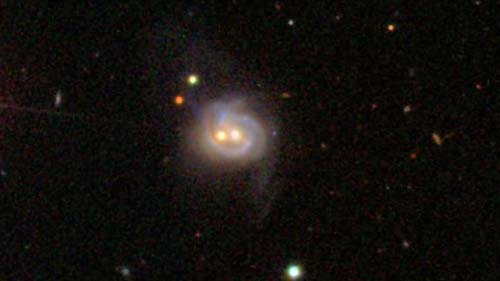
Nature pulls a fast one on astronomers: Two galaxies caught masquerading as one
Islamabad: What might look like a colossal jet shooting away from a galaxy turns out to be an illusion. New data from the National Science Foundation’s Karl G. Jansky Very Large Array (VLA) reveal that two galaxies, one lying behind the other, have been masquerading as one.
In a new image highlighting the chance alignment, radio data from the VLA are blue and infrared observations from NASA’s Spitzer Space Telescope and Wide-field Infrared Survey Explorer (WISE) are yellow and orange, respectively. Visible data are also shown, with starlight in purplish blue and heated gas in rose.
The closer galaxy, called UGC 10288, is located 100 million light-years away. It is spiral in shape, but from our viewpoint on Earth, we are seeing its thin edge. The farther galaxy, seen in blue, is nearly 7 billion light-years away. Two giant jets shoot away from this galaxy, one of which is seen above the plane of the closer galaxy’s disk.
Earlier radio images of the two galaxies appeared as one fuzzy blob, and fooled astronomers into thinking they were looking at one galaxy. Thanks to the VLA pulling the curtain back on the disguised duo, the scientists have a unique opportunity to learn otherwise-unobtainable facts about the nearer galaxy.
“We can use the radio waves from the background galaxy, coming through the nearer one, as a way to measure the properties of the nearer galaxy,” said Judith Irwin, of Queen’s University, Canada, lead author of a recent paper on the findings, appearing online Nov. 15 in the Astronomical Journal.
Observations from Spitzer and WISE helped to reveal new structures above and below the plane of the closer galaxy’s disk. For example, Spitzer helped confirm an arc-like feature rising more than 11,000 light-years above the disk, which was seen in the radio observations.
